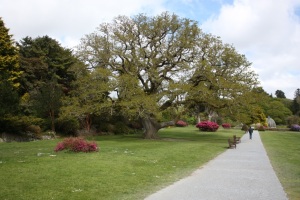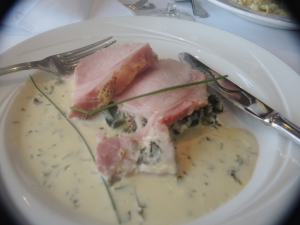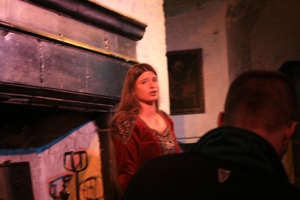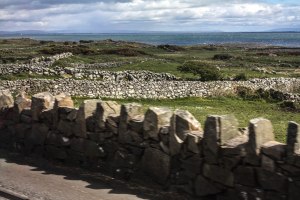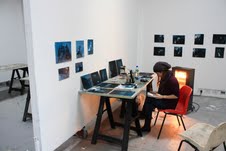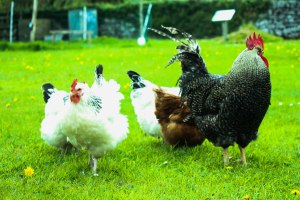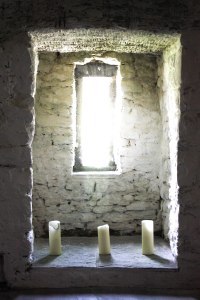Home » Photos (Page 4)
Category Archives: Photos
Something Is “Knot” Right In Sneem, Ireland
By Jenna Vidic
SNEEM, Ireland — Ireland is not only a place of majestic beauty but also a place of myths and folk tale. From the leprechauns to fairies coming out at night, Ireland keeps it very interesting. When coming upon the small village of Sneem, it was very puzzling why and how Sneem was given its nickname: ‘The Knot.’
“There are many, many explanations as to why this town in Ireland is called ‘The Knot.’ But only mine is the true version of why Sneem has the nickname ‘The Knot,'” Batt Burns said jokingly to the 24 students and two professors he is leading during the tour of his hometown.
Some people who have lived in Sneem all their lives claim that at one point in history there was a river that ran through the town, and there was a bridge that overlooked a pond with a large trees on both sides of the river. Perhaps 300 years ago, the tress fell into the middle of the river, combined and formed a knot.
There are other legends throughout Sneem.
One suggests as the tide brings in saltwater, it soon hits the freshwater and they form a spiral that looks like a knot in the water.
Another idea is that the water looks like a bow-tie from a man’s tuxedo. “Some people say they can see the two triangles and the one big knot in the middle that is why they believe it is called ‘The Knot’,” said Mr. Burns.
But as the town has grown older and generations have died out so have other myths and explanations as to how or why Sneem was given that nickname ‘The Knot’. What the real reason why and how the town has been given the nicknamewill never be truly known now or to the generations to come.
The only real truth behind the name lies dead with the people who gave Sneem this curious name as ‘The Knot’.
Ireland’s Muckross House Dazzles Tourists
By Tiffany Brandon
SNEEM, Ireland — “The shrubs, flowers, landscaping, and the view are just absolutely stunning,” said Diana Fleischman, a tourist from Wyoming vacationing abroad in Ireland with her husband.
As she stood alongside Muckross Lake, Fleischman gazed out into the distance admiring the beauty of Ireland’s endless mountain tops, cloudy blue skies, and vast woodlands. While shielding away a glimmer of sunlight with her hand in order to have the clearest view possible, she said “I am just in complete awe. I would give anything to wake up to this view in the morning every day. It is breathtaking.”
Ms. Fleischman was standing on the front steps of the 19th-century Victorian mansion known as the Muckross House. Located deep within the woodlands of Killarny National Park, the Muckross House is a major focal point for many tourists traveling throughout Ireland.
Completed in 1843 by a well-known Scottish architect William Burn, the Muckross House was built for Henry Arthur Herbert and his wife, Mary Balfour Herbert. In preparation for Queen Victoria’s visit in 1861, the Herberts undertook extensive gardening projects around the home in the 1850’s.
Today, the mansion is encircled by three gardens: the Sunken Garden, Rock Garden, and the Stream Garden. The main rooms of the house are designed in a Victorian style-like setting and portray the lavish lifestyle of the 19th-century landowning class. Along with touring the inside of the mansion, visitors have the opportunity to wander through the courtyard and observe the scenic beauty the house has to offer.
While wandering through the various gardens of the Muckross estate, tourists have the opportunity to snap photographs of colorful flowers beginning to blossom this season.
Michael Brinler, a tourist from Maryland, was surprised by how many flowers have been planted around the home.
“It is truly unbelievable,” stated Brinler. “I never have seen so many different types of wildflowers growing in one place like this, not even in Maryland. I travel frequently, and Ireland by far has some of the most beautiful flowers I have ever seen.”
The landscape at the Muckross estate is also quite captivating. Stone trails are built into the hillsides so that visitors can roam through the vegetation and catch glimpses of beautiful trees, shrubbery, and old-fashioned Victorian lawn furniture.
The Muckross house and its vivacious landscape are toured every year by thousands of tourists from all around the world. Although the estate has trees, flowers, and landscaping just like any other historic location would have, tourists still find the Muckross house one-of-a-kind.
“This home is very unique,” said Fleischman. “There are always going to be flowers and beautiful scenery in many places you travel to in life, but it is uncommon to come across a place that has both the beauty and history like the Muckross House does. Not only do you leave with knowledge about the Victorian era and the home’s history, but you walk away feeling mesmerized by the unique beauty of the Muckross House and its remarkable landscape.”
Appreciating Ireland And Its Music
By Paul Wintruba
GALWAY, Ireland — The tourist Mecca. Never in my life would I have thought my travels across the pond, would find me in a traditional Irish pub, listening to a rendition of The Ring of Fire, by Johnny Cash, preformed by an Irish singer.
Sports and Beer
By Chris Mueller
SNEEM, Ireland — I’m sitting at Dan Murphy’s Bar in this village of a little over 300 people. As I and two other companions sat down to the pub counter, we noticed a few other men enjoying what seemed to be their usual pint of Guinness on a clear and cool night.
As we began conversing with the curious group that included the pub’s bartender, we moved among topics ranging from different types of beer to our favorite kinds of music.
But our multi-hour conversation turned for the better when the topic of sports came up. That’s when I came to realize how the atmosphere of sports, even when coming from widely different ends of the spectrum, can bring groups of people together in almost every situation it partakes.
“You guys don’t like that American soccer game do you,” joked Kieran Burns, the bartender. “Because if you did, we’d probably have to smash this glass over your heads. You’re in Gaelic football territory around here.”
There was my cue to not bring up soccer. Why would anyone out of the country pay attention to soccer in the U.S.A. when sufficient numbers of Americans don’t pay attention to it? It started to make sense. And the more we talked about the similarities and differences of professional sports in our respective countries, the greater the urge I had to experience just what they were describing.
“Yeah, there’s nothing like Gaelic football,” said Burns. “It’s about country; it’s about honor, and pride.”
Burns shows off a photo of three players from Sneem who are part of County Kerry’s most famous team. “These three guys all died of old age recently, and were alcoholics, simply because they didn’t have to pay for a drink anywhere they went.”
The bartender was referring to the 1978,’79, and ‘80 County Kerry team that won the cup three straight years.
I instantly referenced those players to majority of the professional superstars in America. These athletes, considered God-like because of their talent, are often treated like royalty wherever they go. And like the three Gaelic football stars, that preferential treatment ultimately becomes the demise of some athletes around the country, resulting in alcoholism, drug-abuse, and bankrupt checking accounts.
Chiming into the conversation was another man who went under the name John, who was wearing a Chicago Bears sweatshirt although he knew nothing about NFL football. He explained he simply liked the colors but “didn’t know a lick of American football.”
As I tried to explain to him the simple rules of the game, his lack of knowledge on American sports showed while he asked questions some kindergartners could answer; but, at the same time, I couldn’t tell him a “lick of Gaelic football” either.
You Can (And Will) Eat Well In Ireland
By Daniel Kitchen
SNEEM, Ireland — Some stereotypes are true.
In Ireland, the stereotypes that the alcohol flows freely and there is a pub for every building in town are true. But what fewer people recognize is that there’s some pretty darn good food there, too.
The Robert Morris University students and faculty on this two-week trip didn’t expect the shortest entrée on the opening night menu to be a 13-word description of an Irish Prime Rib in Red Wine Sauce.
Descriptions such as these are the norm on Ireland’s dining menus. In Sneem, a small-town pub named O’Shea’s, which sells much more food in the later hours than during midday, had 10-word descriptions of its food. The main course was described, but the sides are also focused on, so that you are actually more excited for the small lump in the corner of your plate than the larger one in the center.
The food might sound perfect, but does it taste as good as it sounds?
In one word, yes.
Irish breakfasts are so large and delicious that they can hold you over until dinner, the students again were reminded on a recent morning. Lunches, therefore are smaller, but equally delicious and filling. The common dish at O’Shea’s for lunch, according to the bartender, is a honey-baked ham salad sandwich, which can be accompanied, by request, with french fries. The sandwich is no bigger than one packed for an elementary school child in a lunchbox, and the fries no larger than a side you get at a diner.
But the pure deliciousness of the food holds over so well that a full dinner is not expected.
Dinner rounds out everything, assuming you can somehow remain hungry, and is guaranteed to send you to sleep with a broad smile on your face. Taking advantage of Ireland’s best, and most numerous, stores of food, a common dish involves either seafood or a meat, a potato-based side, and a fresh set of vegetables.
One RMU student voiced the one and only concern she had over the meals.
“Am I the only one who doesn’t like taking any time between courses?” asked Sara Dinwiddie, who, having finished an exotic salad as a starter, was, like her companions, far too impatient to wait for a meal of either salmon in a garlic cream sauce or a marinated chicken roast, followed by white and dark chocolate eclairs for dessert (served with a drizzle of raspberry sauce, of course).
And, in true Irish fashion, there were multiple potato sides served with each dinner option.
Two interesting details to note: First, few areas in the U.S. offer traditional Irish meals; and, second, more often than not when Americans think they are ating Irish food, they are not.
James M. O’Sullivan, a Sneem solicitor, addressed the incorrect feasts held in the U.S. on St. Patrick’s Day.
“I don’t know where you lot got corned beef and cabbage from, but that is not at all what we have on St. Patrick’s Day. If I were to plan a meal for that day, it would be bacon, multiple potato dishes, and colcannon (a traditional Irish dish of mixed cabbage and mashed potatoes),”said O’Sullivan.
While typically delicious, it seems other countries have only a partial truth of just how wonderful the food of Ireland truly is. And having experienced it firsthand, I can testify that they don’t know what they’re missing!
Bunratty Castle Is An Irish Treasure
By Chris Mueller
COUNTY CLARE, Ireland — High within the lushest of the green fields in County Clare stands one of Ireland’s most ancient and important places, Bunratty Castle, where technology and modernism cease to exist.
Funded by the Shannon Heritage Society, Bunratty Castle and the accompanying Folk Park recreate a time period of harsh realities, where self-defense was a necessity dating back to the year 970.
The entrance to the castle leads into a common room, where everything all the way to the hanging wall pieces references a point in the fortress’ history. Even the tour guides are dressed in the clothes of the time periods, wearing long robes and hairstyles of peculiar fashion. The limestone walls of the structure project heat, and the spiral staircases give the impression of a safe-haven.
“The whole appearance of the castle does a really nice job of portraying the ancient time periods,” said Sean Cahill, a tourist visiting from Manchester, England. “I’ve been impressed so far with the entire thing.”
A large emphasis of the castle relayed solely on self-defense. The first inhibitors of the castle, the Vikings, and later Irish rival families, consistently were forced to defend themselves from enemies seeking to invade the giant home. Not only were soldiers frequently stationed around the premises, but even the spiral staircases contained firing holes where hot oil could be poured onto enemies in a last effort of defense.
“The people who lived in this castle were in a different period of time, one that we as individuals are not used to,” explained Hannah, a castle tour guide. “They were frequently dealing with defense, power, and royalty, and therefore had to adapt to the situations. It was scary at times, but they had no other choice. “
In addition to its large focus on defense, Bunratty Castle also contained many different extravagant forms of art and history. From giant elk antlers to ancient pottery figures, the domain held a variety of interesting pieces. It even contained a sculpture where myth stated that any woman who touched it would bear twins within one year.
Bunratty Castle remains a piece of history that cannot be overlooked by anyone with an interest in Irish heritage.
If These Walls Could Talk
By Katie Abramowich
SNEEM, Ireland — The typical American dream home sits on a nicely trimmed yard surrounded by a white picket fence. Such a fence would be unnecessary, maybe even impossible, to construct on the properties of many homes in cities, towns, and suburban areas in the United States.
Simply closing the curtains might suffice for privacy in these neighborhoods, where a narrow alley is often the only separation between homes.
In Ireland, privacy is enjoyed, especially in remote, rural areas. Seemingly natural to the land, stone walls designate one plot of land from another. For miles, the walls separate the vast majority of land in southwest Ireland. To a visitor, these stone walls are beautiful, historic masterpieces. However, Irish landowners see this familiar stone architecture as a burden.
High walls, like the one at Bunratty Castle pictured above, protected the estates of the wealthy
An estimated 250,000 miles of stone walls exist in Ireland. The different heights show both the purpose and the wealth of the original landowner. Batt Burns, an Irish native and a tour guide in Ireland, said high walls were built around estates of the wealthy for protection from foes and wild game.
“Peasants received a wage of about six cents a day to build these walls,” he explained.
The oldest known wall built for this purpose is over 5,000 years old.
The stone walls that wind across the landscape of Ireland today were constructed within the last 200 years. Remarkably, they have stood for nearly two centuries despite the lack of a binding agent between the rocks. At the time of construction, each landowner manually dug these stones from his property, using them to segment land into one-acre plots.
The walls served as barriers between livestock, as well as between neighboring farmlands. Stone was chosen over timber because of the wet climate that would erode any wooden fixtures. Today, Irish citizens specify clearly dictated property lines. Even homeowners that have opted to abolish the walls standing on their property have planted trees or shrubs to distinguish clear boundaries from neighboring land.
Driving along the coast, the beauty of these stone walls cannot be missed. They seem to exist naturally, like a river cutting through rocky mountains, that it was hardly believable that human hands set each stone. The beauty fails to impress many Irish landowners, who have become too familiar with the miles of rocks.
Miles of stone walls, like these pictured above, zigzag across the landscape in southwestern Ireland
“Farmers want their plots of land to be bigger, but the stone walls are in the way,” Burns said.
To solve this problem, farmers demolish them. Others see the thick walls as a waste of land, where a slimmer barbed wire fence could replace them and free up a few feet on either side.
As they stand, these walls offer a story of Ireland’s history. Unfortunately, as more and more people dismantle the barriers, beautiful pieces of Irish history will be lost.
The Cliffs of Moher, From Both Sides of the Pond
By Paul Wintruba
SNEEM, Ireland — If there is one place on the Emerald Isle that never fails to draw its over one million tourists rain or shine, then that would be the Cliffs of Moher.
“Time, Space And Inspiration”
By Haley Sawyer
GALWAY, Ireland — The Burren College of Art, located in County Clare, Ireland, boasts the mantra “Time, Space, and Inspiration,” and with good reason. It is surrounded by the Burren, perhaps one of the most scenic and beautiful spots in the entire Emerald Isle.
Not only is the area awe-inducing, it is also rich in Irish heritage. Stories of the first inhabitants of the area, who appeared shortly after the Ice Age, continue to be passed down through word of mouth and scholarship. The ingredients of education, breathtaking scenery, and historical value all are combined to create a valuable learning experience to both the scholar and artist.
The Burren, located in County Clare, Ireland
One of these scholars/artists is Kate McCannon of West Virginia, U.S.A. After graduating from the Maryland Institute College of Art, McCannon continued her studies at the Burren College of Art.
“I like it because it’s a really unique place,” she said. “This is really quiet and small and simple. It’s not really complicated and I like that. You can really focus on yourself and what you’re doing without any distractions. I really get one-on-one time with me and my work.”
Kate McCannon, an American citizen, is pursuing her graduate studies at The Burren College of Art
Because she is completing a residency, McCannon receives her own studio space, which she has access to 24 hours a day, seven days a week. During this time, she is free to work on whatever she pleases in solitude, which in this case, are figurative oil paintings based on old family photographs.
“I kind of like that, without having someone hovering over my shoulder or telling me what to do,” she said of the alone time. “Sometimes it’s kind of nice when someone is in the studio next door. They come in and we chat. But yeah, I kind of like the solitary aspect.”
A look inside The Burren College of Art
Another artist who calls the Burren College of Art home is photographer Robert Ellis, who is a local of the Burren. Ellis has multiple duties at the school, which include librarian, photo technician, and monitoring of residence applications. He also teaches evening and summer courses in photography. Ellis earned his master’s in photography one year ago.
“I’m very fortunate that my paid position and my love for photography aren’t that separate,” he said. “At the moment in the Irish economy at the moment, there’s very little jobs in photography, so I’m very lucky to be working.”
When not at the school, Ellis works on developing his own work, which includes taking down romantic stereotypes about the Burren.
“I’ve grown knowing about this area, kind of knowing a different version than what I see photographically. I think people who visit the Burren, outsiders, often tend to romanticize and stereotype the Burren and buy into this stereo-romantic notion that I don’t necessarily find to be true,” he said. ” They kind of make it out to be this land that mankind has forgotten, somewhere that’s centuries old. I look for a different kind of Burren. I’ve just been kind of challenging that quietly in my own little way.”
The Burren College of Art provides artists with an opportunity that can rarely be matched by other institutions. Through classes, residencies, and a visiting artist series, the Burren College makes the Burren all the more beautiful.
The Burren College of Art: Bringing Education and Environment Together (A Photo Gallery)
By Katie Abramowich
Burren College of Art, located in County Clare, Ireland, provides students with a serene environment to practice and master their skills in fields such as studio art and art and ecology.
Facilities, including a dark room, library, studios, and a sole lecture hall, are all housed in this building on the college’s property.
Chickens and other beautiful creatures can be spotted frolicking around the grounds
The founders of the college wanted to keep this piece of history intact, so they opted to have this castle refurbished. Finished in 1994, a day before the official opening of Burren College of Art, it now stands as a symbol of history and the importance of education
Light shines brightly through the castle’s windows, helping to display students’ artwork. Because graduating classes are no larger than six students, commencement ceremonies are also held in one of the castle’s rooms
One student created an exhibit that united music with nature. Handcrafted instruments were placed along a short hiking trail, and explorers were encouraged to interact with nature by playing them in accompaniment the sounds of the environment, like singing birds and rustling wind
Twenty studio spaces provide each student with a private working area. Kate McCannon, a student from the United States, is surrounded by her own artwork
The contents of each studio show off the personality and individuality of the student who occupies it







